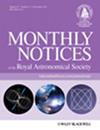Constraints on cosmologically coupled black holes from gravitational wave observations and minimal formation mass
IF 4.7
3区 物理与天体物理
Q1 ASTRONOMY & ASTROPHYSICS
引用次数: 0
Abstract
We test the possibility that the black holes (BHs) detected by LIGO-Virgo-KAGRA (LVK) may be cosmologically coupled and grow in mass proportionally to the cosmological scale factor to some power k, which may also act as the dark energy source if k ≈ 3. This approach was proposed as an extension of Kerr BHs embedded in cosmological backgrounds and possibly without singularities or horizons. In our analysis, we develop and apply two methods to test these cosmologically coupled BHs (CCBHs) either with or without connection to dark energy. We consider different scenarios for the time between the binary BH formation and its merger, and we find that the standard log-uniform distribution yields weaker constraints than the CCBH-corrected case. Assuming that the minimum mass of a BH with stellar progenitor is 2M⊙, we estimate the probability that at least one BH among the observed ones had an initial mass below this threshold. We obtain these probabilities either directly from the observed data or by assuming the LVK power-law-plus-peak mass distribution. In the latter case we find, at 2σ level, that k < 2.1 for the standard log-uniform distribution, or k < 1.1 for the CCBH-corrected distribution. Slightly weaker bounds are obtained in the direct method. Considering the uncertainties on the nature of CCBHs, we also find that the required minimum CCBH mass value to eliminate the tensions for k = 3 should be lower than 0.5 M⊙ (again at 2σ). Finally, we show that future observations have the potential to decisively confirm these bounds.从引力波观测和最小形成质量看宇宙耦合黑洞的制约因素
我们检验了这样一种可能性:LIGO-Virgo-KAGRA(LVK)探测到的黑洞(BHs)可能是宇宙学耦合的,其质量增长与宇宙学尺度因子成比例,达到某个幂k,如果k≈3,它也可能充当暗能量源。这种方法是作为嵌入宇宙学背景的克尔黑洞的扩展而提出的,可能没有奇点或地平线。在我们的分析中,我们开发并应用了两种方法来检验这些与暗能量有关或无关的宇宙耦合BH(CCBH)。我们考虑了从双 BH 形成到其合并之间的不同时间方案,发现标准对数均匀分布比 CCBH 校正方案产生的约束更弱。假设有恒星祖先的 BH 的最小质量为 2M⊙,我们估算了观测到的 BH 中至少有一个的初始质量低于这个临界值的概率。我们可以直接从观测数据中得到这些概率,也可以通过假定 LVK 质量幂律加峰分布得到这些概率。在后一种情况下,我们发现在2σ水平上,标准对数均匀分布的k < 为2.1,而CCBH校正分布的k < 为1.1。直接法得到的界限稍弱。考虑到 CCBH 性质的不确定性,我们还发现,消除 k = 3 的张力所需的最小 CCBH 质量值应该低于 0.5 M⊙(同样是 2σ)。最后,我们表明未来的观测有可能决定性地证实这些界限。
本文章由计算机程序翻译,如有差异,请以英文原文为准。
求助全文
约1分钟内获得全文
求助全文
来源期刊

Monthly Notices of the Royal Astronomical Society
ASTRONOMY & ASTROPHYSICS-
CiteScore
9.10
自引率
37.50%
发文量
3198
审稿时长
3 months
期刊介绍:
Monthly Notices of the Royal Astronomical Society is one of the world''s leading primary research journals in astronomy and astrophysics, as well as one of the longest established. It publishes the results of original research in positional and dynamical astronomy, astrophysics, radio astronomy, cosmology, space research and the design of astronomical instruments.
 求助内容:
求助内容: 应助结果提醒方式:
应助结果提醒方式:


